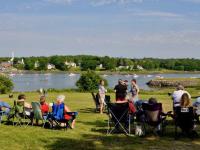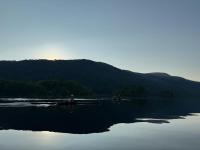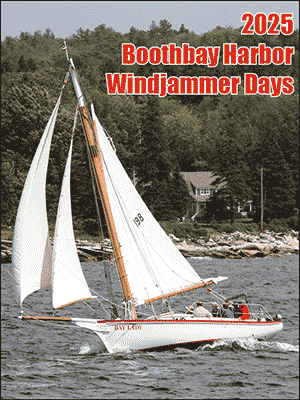A thank-you letter to the Camden Public Library Trustees
As the designated stewards of Harbor Park, the Trustees of the Camden Public Library recently made a momentous decision to make regarding the June 10 town vote on the future of Montgomery Dam. They voted unanimously, with one abstention, to support the removal of Montgomery Dam.
Mary Louise Curtis Bok, who was both Camden Public Library’s primary benefactor and Harbor Park’s founder, left the future of her most cherished gift to Camden, not to the Town. She wanted to ensure that future decisions would be done by citizens whose primary responsibilities would be to these intertwined entities – the Park and the Library – and not to the winds and whims of the day.
While researching the records when I was writing Where the Mountains Meet the Sea – A History of Camden Harbor 1900-2000, for the Camden Public Library in 2009, I came across firsthand documentary evidence of Mary Louise Curtis Bok’s long-term vision for the Park.
Mary Louise Curtis Bok had a 100-year vision for the center of Camden, especially around its harbor and she dedicated decades to implementing her vision.
In 1916 she bought an initial parcel at the corner of Main and Atlantic streets where she envisioned the library would someday be built – which it was, 12 years later in 1928. Even before launching the library building project, Bok had begun assembling the parcels along the waterfront that blocked the view of the harbor from the library.
Mary Louise Curtis Bok conceived of what would become Harbor Park as a grand natural setting to connect the garden spaces of the Amphitheater adjacent to the Library with beautiful expansive views of Camden Harbor she aimed to create.
She hired the most prominent landscape design firm in the country, the Olmsted Brothers in Boston, to plan and oversee the construction of Harbor Park. She insisted on hiring local laborers, woodsmen, farmers and craftspeople during the bleak times of the Depression.
When Bok and the Olmsted Brothers began planning and building the Harbor Park between 1928 and 1931, one of their key design and construction challenges was the need to stabilize the southern edge of the property that abutted Montgomery Dam. The dam and a long granite and masonry wall had originally been engineered to divert waterpower to the industrial enterprises along the waterfront. But the dam was leaking and the dam’s sidewall leading down to the harbor was deteriorating structurally. Extensive repairs were needed for the Park project to proceed.
Montgomery Dam was owned at the time by Hugh Montgomery. In addition to the repair challenges Montgomery faced, the dam’s prime customer, the Camden Anchor Works and Rockland Engine Company on the waterfront had shut their doors in 1926.
Although townspeople hoped for a new business to occupy the premises, the stock market crash of 1929 brought an abrupt end to that desire. Deprived its major customer, the Montgomery Dam’s owner could not afford its costly repairs and reconstructiuon.
Through an emissary, Montgomery agreed to allow Bok’s Park project to go forward to completely rebuild the dam and dam’s sluiceway wall, which was at boundary of the proposed park if she would pay for them. Local tradesmen were hired and the reconstruction of the dam then began in 1930.
I think most reasonable people would conclude that Mary Louise Curtis Bok rebuilt the dam to enable the creation of Harbor Park, in spite of her instinctive aversion to any industrial intrusion.
With this challenge resolved, the Olmsted’s designed a graceful arcing path along the edge of the dam and river and with low trees and shrubs carefully screened views of the dilapidated industrial structures on the other side of the harbor to create as natural an environment and landscape as possible because Bok did not want an industrial view to be the outlook from the Park.
As a final piece of her vision, following the Great Harbor Fire of 1935 when the industrial buildings burned on the western side of the harbor, Mary Louise Curtis Bok quickly stepped in and bought the property, tore down the derelict factory buildings to create additional open space at what is now the Camden Public Landing and she envisioned a bridge that would connect Harbor Park and the Public Landing. What a big vision!
During the past several decades at Harbor Park, seawalls of various heights and designs have been constructed along its waterfront, which are periodically destroyed and then rebuilt. Harbor Park’s seawall is currently being undermined by a combination of rising seas, river flooding and storm damage.
When the seawall is rebuilt as it needs to be, the Trustees of Harbor Park must consider a long-term plan to contend with climatic uncertainty, which means either a much higher seawall (11 feet) or a landscape design that does not try to hold back the sea and the river – in other words, a redesigned edge for Harbor Park, which would be borne by taxpayers and library donors.
Camden Public Library’s Trustees have provided a recommendation to remove Montgomery Dam. The historical record is clear. As a longtime supporter of the Camden Public Library, I am heartened that such a careful and thoughtful Library Board, along with many other library supporters have made a wise and informed decision demonstrating that the vision and legacy of Mary Louise Curtis Bok are alive and well.
For Camden Residents, Please Vote Yes on 7 – and Save Taxes
Philip Conkling lives in Camden

























